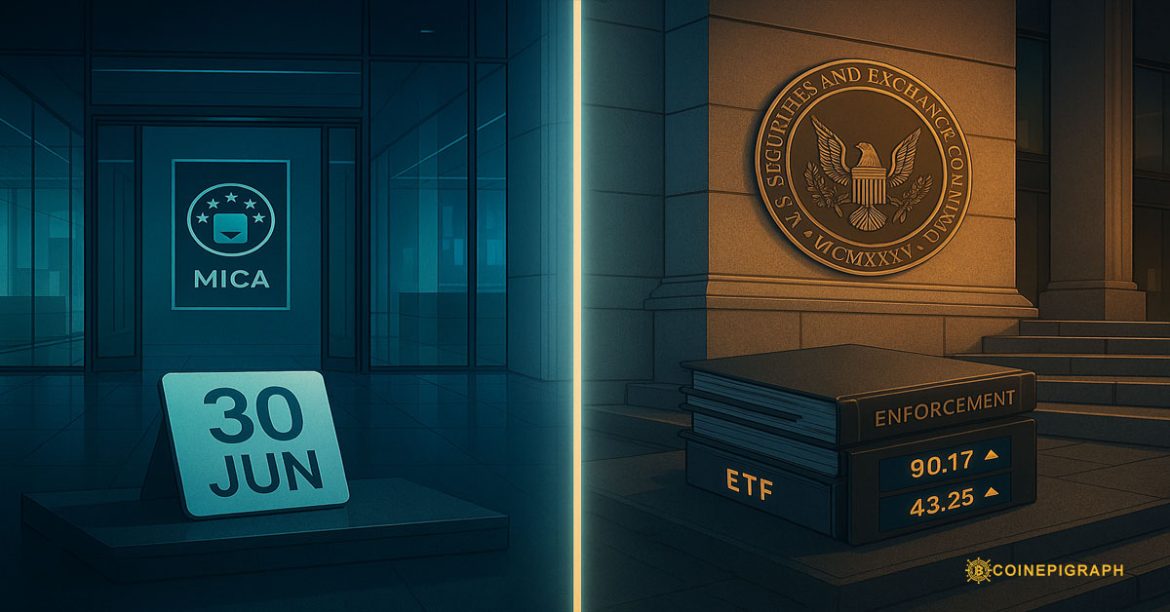CoinEpigraph Editorial Desk | October 12, 2025
TL;DR
The EU’s MiCA is a rulebook with passports and clocks; the U.S. remains a case-by-case regime anchored to securities law and enforcement. Europe’s stablecoin rules have been live since June 30, 2024, with CASP licensing rolling in from December 30, 2024; firms know the path to authorization and cross-border service. In the U.S., headline approvals (spot BTC and ETH ETFs) coexist with accounting headwinds (SAB 121) and litigation risk, leaving compliance as a venue- and product-specific art. Builders must design for a world where MiCA standardizes and the SEC interprets—and route liquidity accordingly.
Two models of legitimacy
MiCA (EU): A single framework governing issuance and intermediation of crypto-assets, with specific titles for EMTs/ARTs (fiat-referenced and asset-referenced “stablecoins”) and a passportable license for CASPs (exchanges, brokers, custody). Calendar certainty is the feature: stablecoin obligations applied June 30, 2024; the main CASP authorization regime started December 30, 2024 with transitional options up to mid-2026 depending on the Member State.
United States (SEC-led): No dedicated, comprehensive statute. Policy is expressed via enforcement, staff guidance, exchange rulemaking, and product approvals (ETFs). The SEC green-lit spot Bitcoin ETFs on Jan 10, 2024, then cleared spot Ether ETFs to trade in July 2024—milestones that opened compliant rails for exposure but did not resolve token-classification or custody accounting across the stack.
Stablecoins: Europe’s rules vs America’s questions
EU: Under MiCA, EMT/ART issuers face reserve quality, liquidity, disclosure, and redemption duties; supervisors published clarifications through 2024–2025 (ESMA/EBA statements) and are actively guiding treatment of non-MiCA-compliant products served into the EU. Practically, several venues restricted access to unaligned stablecoins after June 2024 to stay within the new perimeter.
U.S.: Congress considered multiple bills; none created an EU-style national regime. Issuers navigate state money-transmitter rules, bank partnerships, and federal scrutiny while watching how ETFs and broker-dealer policies inform “acceptable” exposure. Translation: more optionality, less predictability. (Inference based on current legislative landscape and SEC posture.)
Market rails: where ETFs fit
ETF approvals changed the U.S. distribution game. Spot BTC ETPs (Jan 2024) and spot ETH ETFs (trading by late July 2024) gave RIAs and pensions a compliance-grade exposure path while leaving token listing and secondary trading of many assets under the same interpretive fog. Meanwhile, exchanges still calibrate listings and staking products against enforcement risk. In the EU, firms that secure a MiCA passport can serve 27 countries off a single authorization, reducing fragmentation.
The accounting drag: SAB 121
The U.S. accounting bulletin SAB 121 treats crypto safekeeping as an on-balance-sheet obligation for reporting entities—discouraging banks from custody at scale. Congress voted to rescind it in 2024, but the President vetoed the resolution, leaving the bulletin in force into 2025 (even as pressure to revisit it grew). Net effect: a structural headwind for bank-grade custody absent further rulemaking.
Passport vs. Precedent: how strategy changes
- Licensing path: MiCA supplies a named license (CASP); U.S. pathways vary (state MTLs, broker-dealer/ATS, trust charters, banks). EU favors pre-clearance; U.S. favors interpretation after action.
- Time-to-market: MiCA’s clock + passport can compress EU rollout; U.S. speed hinges on product type (ETFs = yes; token listings/staking = maybe), venue, and enforcement risk.
- Cross-border ops: EU wins on single-market reach; U.S. remains the largest liquidity pool but with product-by-product rules. (Inference; ETF/market size context.)
- Bank participation: MiCA-aligned clarity + EU prudential coordination vs. U.S. SAB 121 headwinds; this shapes custody, repo, and tokenized cash uptake.
Practical playbooks (builders, treasurers, exchanges)
For issuers & fintechs (EU-first):
- Map your token and service into MiCA’s categories (EMT/ART/other) and pre-engage with your lead NCA (national competent authority).
- Build reserve, disclosure, and redemption ops to the June 2024 EMT/ART standard; publish daily look-through where possible.
- Use the passport to expand, but plan for Member-State wrinkles (advertising, consumer law, AML overlays).
For U.S. market access (product-specific):
- If your exposure can be securitized (index, futures, ETF adjacency), explore ETF rails or exchange-listed notes.
- For tokens & staking, assume heightened Howey/Exchange Act scrutiny; instrument design and distribution will decide your risk envelope.
- Custody with banks? Price in SAB 121 capital impact or use non-bank trust models while monitoring any revision.
For global exchanges/custodians:
- Dual-track: obtain CASP authorization in the EU while ring-fencing U.S. lines that are most at risk of enforcement treatment.
- Harmonize disclosure: EU-grade reserve and risk reporting travels well and reduces frictions with U.S. institutions even if not mandated.
Where this is going (12–24 months)
- EU consolidation: Expect fewer, larger CASPs post-authorization and sharper supervision of EMT/ART redemption and marketing. ESMA/EBA will keep publishing Q&A/public statements to close gaps.
- U.S. patchwork + product rails: More ETF-like rails for the largest assets; continued uncertainty for long-tail tokens unless Congress acts or courts force clarity.
- Routing liquidity: Global players steer consumer flows to MiCA-aligned products for predictability; institutional U.S. flows grow through ETFs and tokenized cash/collateral pilots as accounting/policy evolves.
👉 “The CoinEpigraph Bottom Line”
MiCA turns compliance into a design space—know the category, earn the passport, scale the single market. The SEC turns compliance into a strategy game—pick the product, venue, and counterparty stack that can survive reinterpretation. The winners won’t wait for convergence; they’ll ship for both worlds, pricing certainty in the EU and optionality in the U.S. at the same time.
At Coinepigraph, we pride ourselves on delivering cryptocurrency news with the utmost journalistic integrity and professionalism. Our dedicated team is committed to providing accurate, insightful, and unbiased reporting to keep you informed in the ever-evolving crypto landscape. Stay tuned as we expand our coverage to include new sections and thought-provoking op-eds, ensuring Coinepigraph remains your trusted source for all things crypto. -Ian Mayzberg Editor-in-Chief
The team at CoinEpigraph.com is committed to independent analysis and a clear view of the evolving digital asset order.
To help sustain our work and editorial independence, we would appreciate your support of any amount of Bitcoin/Satoshi to this address below: 3NM7AAdxxaJ7jUhZ2nyfgcheWkrquvCzRm
and through our Support Page.
🔍 Disclaimer: CoinEpigraph is for entertainment and information, not investment advice. Markets are volatile — always conduct your own research.
COINEPIGRAPH does not offer investment advice. Always conduct thorough research before making any market decisions regarding cryptocurrency or other asset classes. Past performance is not a reliable indicator of future outcomes. All rights reserved 2024-2025.




